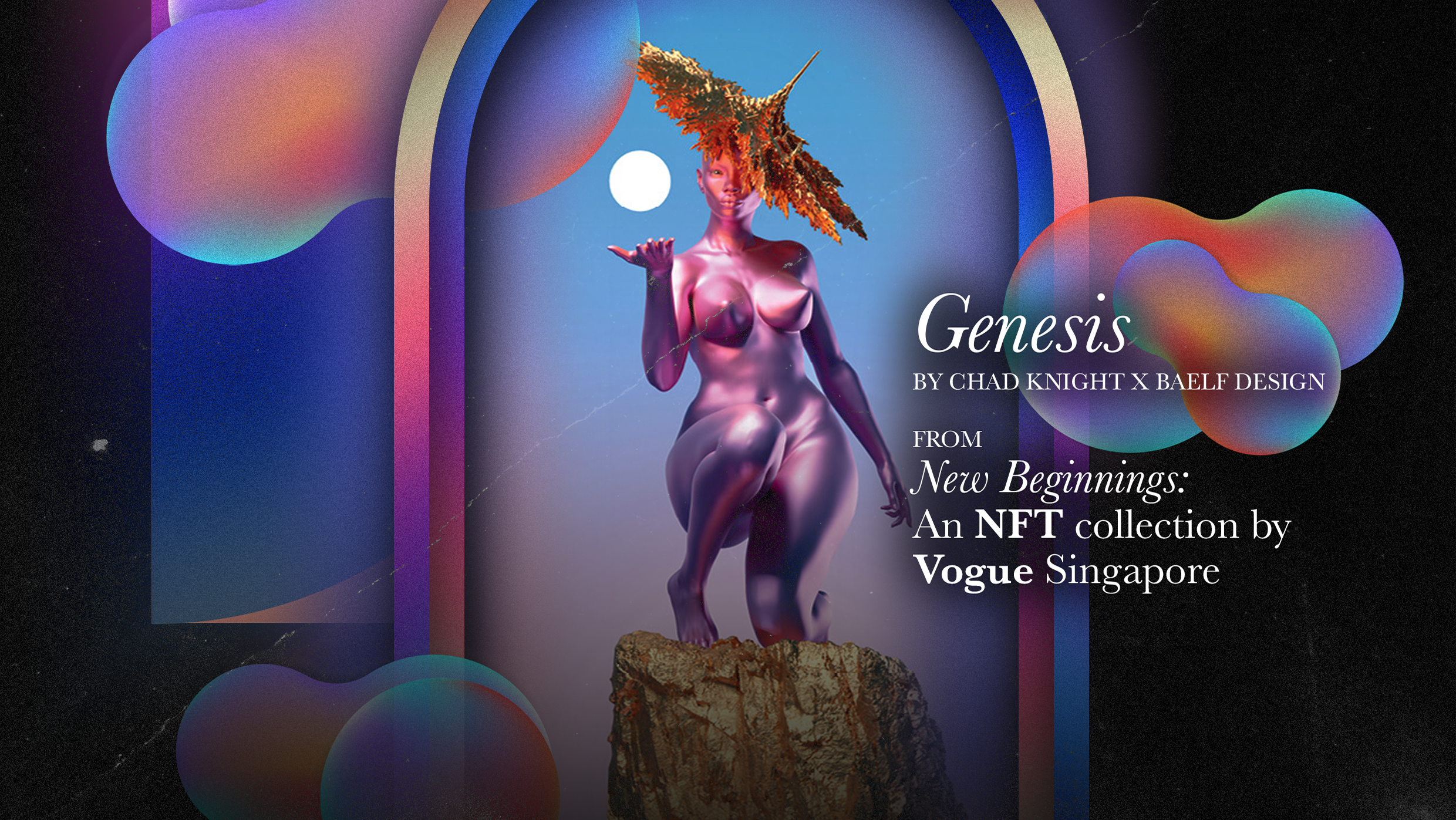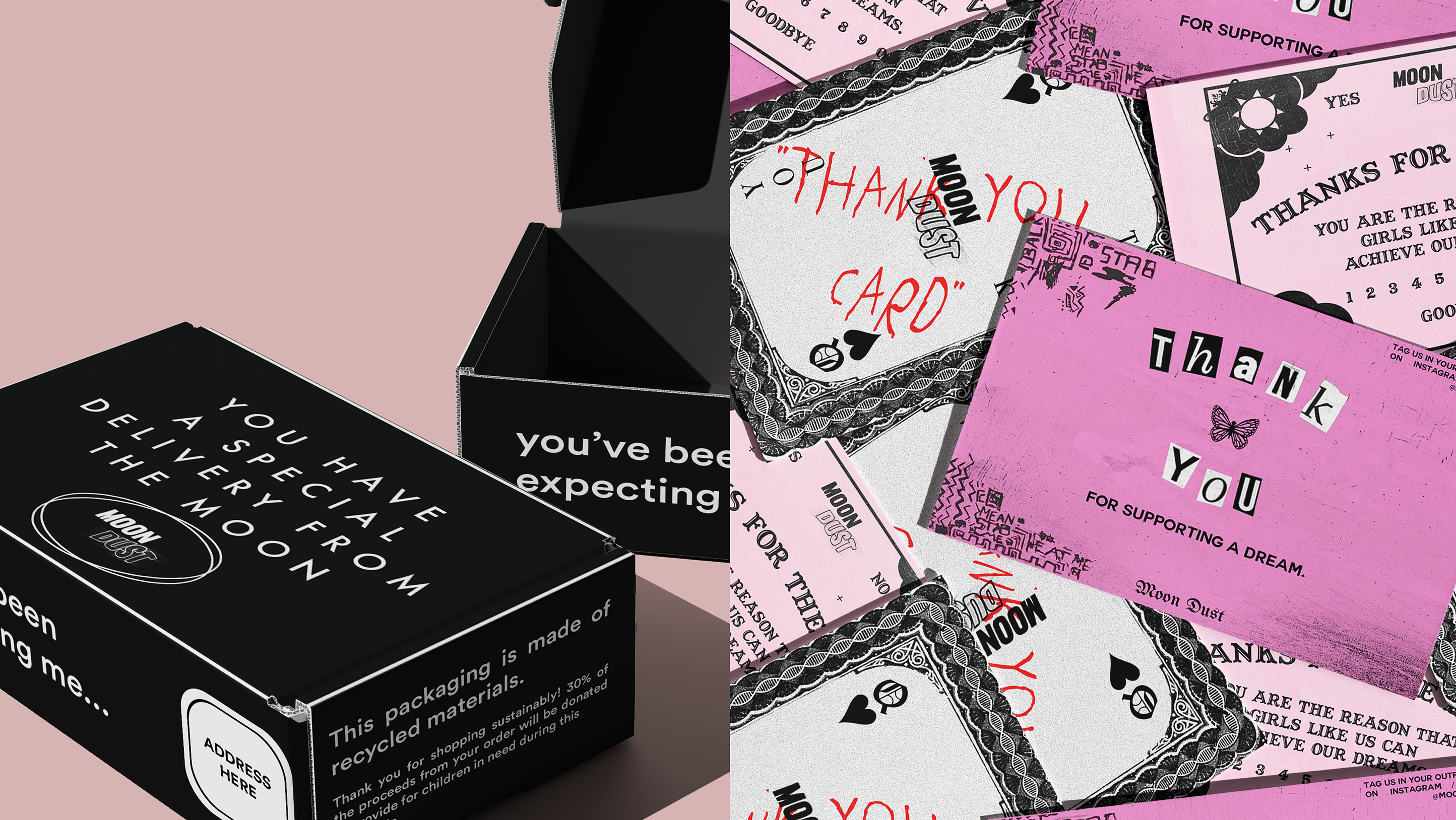Context
This is an independent project sparked on a warm night in Singapore, with the help of Charles Loy – a harsh critic, a technical advisor, and a close friend. I was sharing about how frustrating it can get when you have an activity you want to do, but no one to do it with. If only we could leverage technology for a solution... It was one of those cliché, we-need-to-make-this-into-a-startup moments. A college classic.
Time Frame
4 weeks: June - July 2022
Role & responsibility
All the hats: idea conception, design, information architecture, site-mapping, user flows, low to hi-fidelity wireframing, prototyping, research plans, usability testing, synthesis.
The full interactive prototype can be found here: https://tinyurl.com/bdcrcwfu



Introduction
Making friends should be easy and spontaneous, yet nowadays, many people feel quite the opposite. How do we get make it easier for people to go out with new friends? Think Eventbrite, but advertises directly to people who want to go and can go together. Fast-game friend-matching to connect with people nearby at any time by regularly updated trendy activity ideas. All without the capitalizing on romantic intentions like dating apps do.
Problem Statement
People feel hindered from doing activities that they want to do if they have to do it alone. Trying to find a friend with similar interests is difficult and exhausting to do in a physical setting. From here, I framed the problem as a "How might we..." question, as follows.
How might we facilitate the building of genuine friendships through connecting people with similar activity interests?
In looking into possible solutions for this problem, I decided I wanted to make space for both people suffering from social alienation, but also people who simply want a spontaneous and painless way of obtaining company for an activity of choice. Hence, I identified 3 objectives for my user research:
1. Identify pain points on socially anxious people hindering them from reaching out
2. Identify pain points of social adept people hindering them from going out when they want to
3. Identify how to foster a low-barrier and intentional environment for friendhsip-making
Interviews & Key Insights
I interviewed 9 college students and 2 graduate students from varying majors, since social networking is a prominent aspect for demographics in their early 20s. Their responses were very insightful and is summarized in the following:
1. 8 out of 9 participants feel the desire to have more friends.
2. Participants almost always feel the need to skip an event if they have to go alone, or in other words, do not find any company to go with.
3. Participants sometimes feel limited in the range of activities they can do dude to conforming to the preferences of their existing friend group.
4. Participants are afraid to go on existing matching apps to find friends in fear that they will judged for how they look, or being approached by people with ulterior motives.
5. When going to events, participants find comfort if someone they know is already inside, who they can look for when they arrive.
6. Participants tend to avoid small talk in public events with people they don't know because they find it anxiety0inducing and time-consuming.
Solution
Based on the insights I gained, I decided to approach the solution as a mobile app for young people aged 18-35, designed to be straightforward, accessible and customizable for users. The features of the app and the functions they perform is listed as the following:
1. Profile: The profile holds the users data and lets the user decide what to show others. It has a tab for a deck of cards, each written with an activity/event of the user's interest. This is what is shown to other users, and what the system uses to show the user matches.
2. Build a deck: Users browse through activity/event ideas put out by users of the app or by themselves, or cards stacked on each other. If they are interested in the activity, they have the option to draw it and add it to their deck, which will be used to match users with each other.
3. Find friends: Users swipe through people's profiles and choose who they are interested in befriending. Users who swipe right on each other and matched and allowed to send a message to each other.
4. Messaging: Users can converse with the people they match with, categorized by the activity they chose to put on their deck.
Value Proposition
Make lasting friends through activities – easy, fun and straightforward.
Prototyping
The app will have 4 tabs, and the idea is to keep the functions as simple and straightforward as possible. The app is deisgned to be intuitive - it employs feature patterns that we've seen and been familiarized to before: swipe right and left, the chat room layout, the profile layout. I decided to prototype the hi-fi version on a black background to make the contents pop out using negative space.



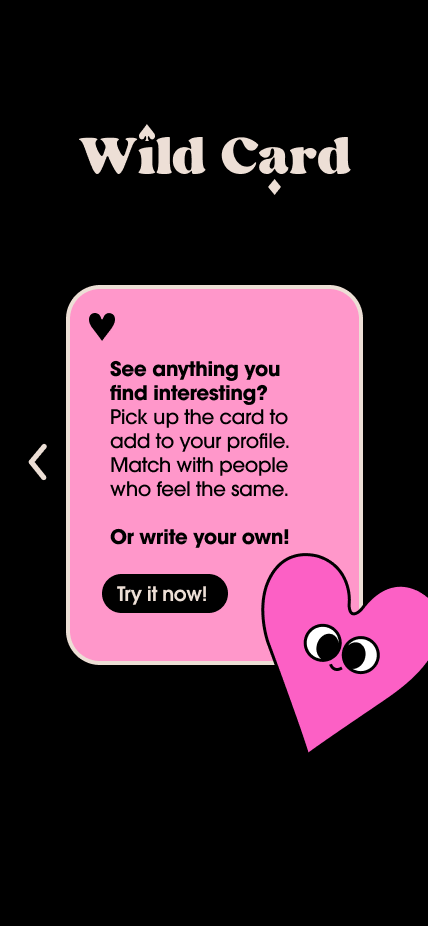
Upon opening the app, the users will be guided through an idea of what kind of activities they can expect to look for on the app. I designed some cute, slightly goofy, diverse set of characters to set the friendly vibe. The pop or vibrant colors amplify this tone.
Users will then be taken to the Build-a-Deck tab, where they can draw cards that contain activities of their interest, or discard those that are not. In practice, the system learns this way and refines predictions of what activities should be show next. Users also have the choice to write their own activity card to put in the deck for other people to draw.


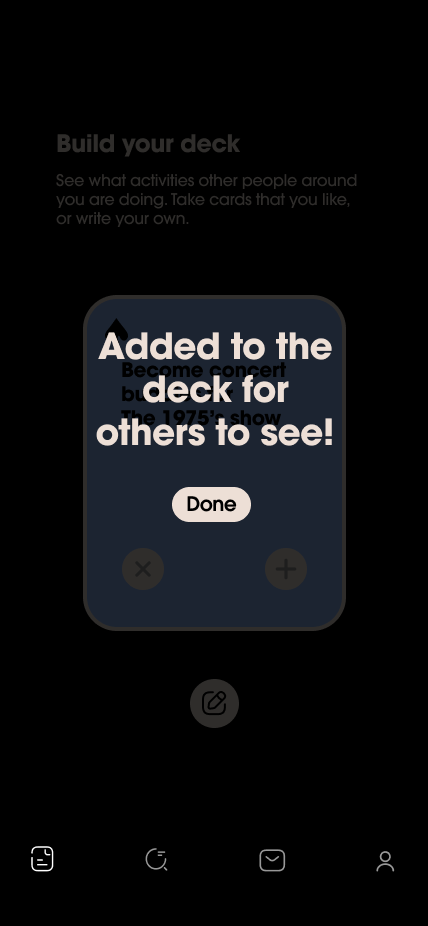
Finding people to match with is very straightforward. Users are reminded of the old swipe-right and swipe-left motion, and they are notified if they have successfully matched with another person.

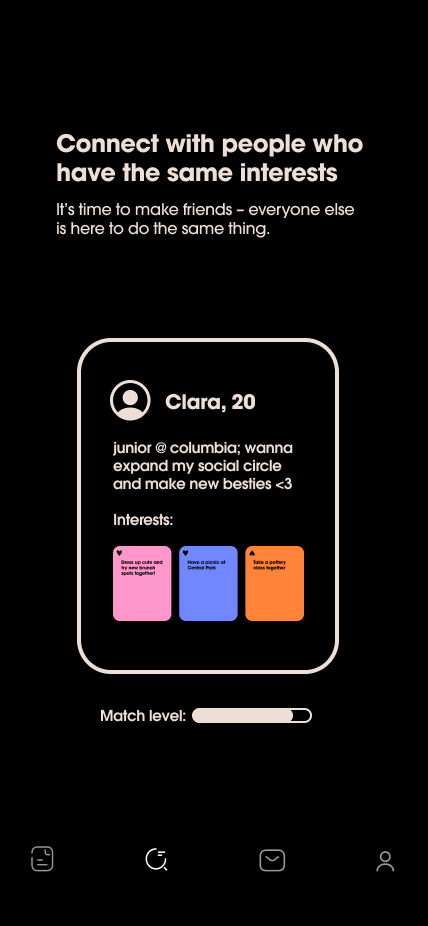

Messaging and profile are intuitive and employ conventional-standard functionality and design. Users can jump top conversations based on the match's mutual interest. The profile shows that there is minimal emphasis on physical looks and uses an icon to give a profile face, instead of filling up a whole screen.




Usability Testing
I invited 4 of my initial participants to participate in a usability test of my interactive Figma prototype. The tests were conducted over a video call either through Gmeets or Zoom depending on the user’s preference. Each participant was sent a link to the prototype at the beginning of the session to assure that they don’t look through it beforehand.
The usability tests consisted of a few simple tasks for the participants to accomplish using the app, all the while testing if they are able to easily navigate through it. Essentially, I wanted to know:
- How the participants interacted with the prototype
- What they would usually click upon being given a task
- If there are any points of confusion upon using it
- What were their expectations before clicking on things.
Results & Potential Improvements
From the usability tests, I learned that participants are generally favorable of the idea of lowering barriers to find hang-out buddies and creating an intentional environment. Users were able to easily navigate between the different tabs, and although some were confused about the swiping motions due to the restrictions of the MVP, users were quick to understand the purpose of the app. Some also questioned the idea of "deck of cards", but soon realized that it meant the texts were card-shaped.
Some potential improvements brought up were:
- Utilize the symbols to categorize activities for faster and easier navigation
- Make the onboarding process clearer: the arrow on the first screen can be replaced with a more informative button
- The deck-building part can be replaced with a scrolling motion so users can return to an activity they might've accidentally skipped.
- Show the match level between users to show people the highest percentage matches
Moving Forward
For future iterations of this project, I would like to explore integrating built-in events suggestion feature in chat rooms, so users can easily choose from them to talk about with their conversation partner. I also want to include question prompts in user profiles so their personality can shine better. Finally, I want to explore the possibility of having a memories space for the activity cards you drew and ended up doing.

